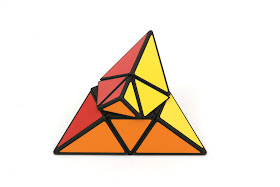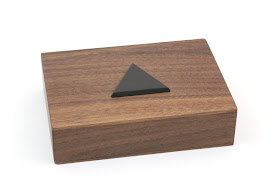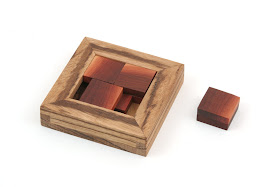The chest conceals 16 separate compartments, which are hidden and locked in a variety of creative ways. It is quite a difficult puzzle, so I attempted it with the help of Peter Wiltshire and Brian Young, plus the occasional hint from Jim.
 Above is a photo showing how it starts: the basket with three eggs is part of the puzzle! The tricky thing about a puzzle like this, is that it is difficult to tell where to start. Each surface is quite large, and could contain something important! It definitely helped to have another few sets of eyes (and brains)!
Above is a photo showing how it starts: the basket with three eggs is part of the puzzle! The tricky thing about a puzzle like this, is that it is difficult to tell where to start. Each surface is quite large, and could contain something important! It definitely helped to have another few sets of eyes (and brains)!The whole thing was a bit of a blur of secret compartments, magnetic locks, and more, so I can't really get too much into the actual details, but suffice it to say that it was a real blast to solve! One of my favorite parts about puzzle boxes is seeing new and unique mechanisms, and creative ways of applying old principles, and this chest was just jam packed!
I think it ended up taking us a good hour or two to finish finding everything, even with some hints from Jim. On your own, without any hints, it could definitely take a day, probably more!
It was getting pretty late at this point, but I couldn't help but try out a few of the exchange puzzles. I picked up Slap Shot Puzzle, Allan Stein's exchange, since it looked pretty unusual. As an experienced puzzle, I didn't find it particularly challenging, since it uses a familiar trick. It is pretty neat because the trick is related to the object, so that was a nice touch.
 Next I tried Hyperboloid Six-Piece Burr, Naoaki Takashima's exchange. The goal is to assemble the six pieces into a cube, which pretty much is like your standard diagonal burr design. However, Naoaki mentioned that he recently discovered that a 7th piece could be added as well, and included that in his exchange too! At first, it is a bit tricky to see how a 7th piece could possibly fit, but after a bit of fiddling, I had figured it out. Not too challenging, but a neat idea. I think this may have worked better in a more slippery medium than wood, since the fit is quite snug. Maybe metal or plastic would be good.
Next I tried Hyperboloid Six-Piece Burr, Naoaki Takashima's exchange. The goal is to assemble the six pieces into a cube, which pretty much is like your standard diagonal burr design. However, Naoaki mentioned that he recently discovered that a 7th piece could be added as well, and included that in his exchange too! At first, it is a bit tricky to see how a 7th piece could possibly fit, but after a bit of fiddling, I had figured it out. Not too challenging, but a neat idea. I think this may have worked better in a more slippery medium than wood, since the fit is quite snug. Maybe metal or plastic would be good. Another one that had intrigued me was Encircling the "X" Puzzle, Abraham Jacob's exchange. I liked that it only had two pieces, often these types of puzzles prove to be pretty interesting! It was particularly intriguing since both pieces were rigid, so it doesn't seem to give you a lot to work with.
Another one that had intrigued me was Encircling the "X" Puzzle, Abraham Jacob's exchange. I liked that it only had two pieces, often these types of puzzles prove to be pretty interesting! It was particularly intriguing since both pieces were rigid, so it doesn't seem to give you a lot to work with.After a few tries, I was able to get the ring on, but it used a good deal more force than I thought was appropriate. I'm not sure if I did it right, but it seemed like there was only one way to get the ring back off, and it used similar force. Definitely not ideal, since you don't want folks to get into the habit of forcing your puzzles!
 Finally, I decided to try Bram Cohen's exchange, Holistic Ring. It is "holistic" because all four bands need to move simultaneously to assemble or disassemble the ring. This contrasts with the typical design, where the outer bands fold outward first.
Finally, I decided to try Bram Cohen's exchange, Holistic Ring. It is "holistic" because all four bands need to move simultaneously to assemble or disassemble the ring. This contrasts with the typical design, where the outer bands fold outward first.Throwing caution to the wind, I took the ring apart and scrambled it up. I figured I had done enough puzzle rings to be able to figure this one out, but who knows! It took a bit of work to figure out what went where, since it differs from the traditional design, but I eventually got it figured out. It is neat to see one of his new puzzle ring designs in person! It would be great to try one in metal, since the pieces would slide together much more smoothly, I would imagine. Of course, that would have probably been prohibitively expensive for an exchange.
At this point I was pretty exhausted, and headed to bed. Jeff's house was so full of puzzlers that Clayton and I ended up sleeping out in his neighbor's motor home, which he was kind enough to loan to Jeff for the occasion! It was pretty neat, I'd never slept in a motor home before! There's something appealing about having everything you need in such a compact space.
Stay tuned for Part 3!














































